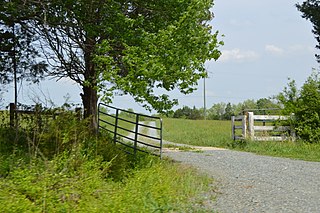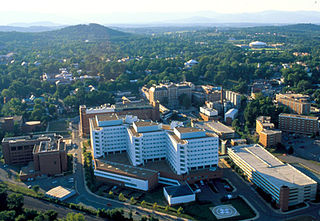
Fluvanna County is a county located in the Piedmont region of the Commonwealth of Virginia. As of the 2010 census, the population was 25,691. Its county seat is Palmyra.

Albemarle County is a county located in the Piedmont region of the Commonwealth of Virginia. Its county seat is Charlottesville, which is an independent city and enclave entirely surrounded by the county. Albemarle County is part of the Charlottesville Metropolitan Statistical Area. As of the 2010 census, the population of Albemarle County was 98,970, more than triple the 1960 census count.

Lake Monticello, a private gated community, is a census-designated place (CDP) in Fluvanna County, Virginia, United States. The population was 9,920 at the 2010 census, an increase of over 44% from 2000. The community is centered on a lake of the same name, which is formed by a dam on a short tributary of the nearby Rivanna River. Lake Monticello is part of the Charlottesville Metropolitan Statistical Area. Lake Monticello was developed in the 1960s as a summer vacation home community but quickly evolved into a bedroom community of Charlottesville, and to a smaller extent of Richmond. It also has a sizable retirement age population.
Randolph Jefferson was the younger brother of Thomas Jefferson and a planter.

Martha Jefferson "Patsy" Randolph was the eldest daughter of Thomas Jefferson, the third President of the United States, and his wife Martha Wayles Skelton Jefferson. She was born at Monticello, near Charlottesville, Virginia.
Lucy Jefferson Lewis, née Lucy Jefferson was a younger sister of United States President Thomas Jefferson and the wife of Charles Lilburn Lewis.

Shadwell is a census-designated place (CDP) in Albemarle County, Virginia, United States, located by the Rivanna River near Charlottesville. The birthplace of Thomas Jefferson, it was named for the Shadwell parish in London by his father, Peter Jefferson, a colonist and planter in central Virginia. Shadwell is the parish where his wife Jane Randolph had been christened. Peter Jefferson and Jane Randolph had six children, among them Thomas, who would become the third president of the United States. Active in county meetings Peter was appointed Justice of the Peace of Albemarle county, taking his oath in September 1744. The following month he was appointed lieutenant colonel to the Albemarle county militia.

The Rivanna River is a 42.1-mile-long (67.8 km) tributary of the James River in central Virginia in the United States. The Rivanna's tributaries originate in the Blue Ridge Mountains; via the James River, it is part of the watershed of Chesapeake Bay.

State Route 53 is a primary state highway in the U.S. state of Virginia. Known as Thomas Jefferson Parkway, the state highway runs 18.32 miles (29.48 km) from SR 20 near Charlottesville east to U.S. Route 15 in Palmyra. SR 53 connects the county seats of Albemarle and Fluvanna counties. The state highway also provides access to the community of Lake Monticello and Monticello, the estate of Thomas Jefferson. The route of SR 53 became a state highway in 1930; the highway receives its present designation in 1947.

Castle Hill (Virginia) is an historic, privately owned, 600-acre plantation located at the foot of the Southwest Mountains in Albemarle County, Virginia, near Monticello and the city of Charlottesville, and is recognized by the Virginia Landmarks Register and the National Register of Historic Places. Castle Hill was the beloved home of Dr. Thomas Walker (1715–1794) and his wife, Mildred Thornton Meriwether. Walker was a close friend and the physician of Peter Jefferson, and later the guardian of young Thomas Jefferson after his father's death.

Advance Mills, also known as Fray's Mill, is an unincorporated community in Albemarle County, Virginia.

Frascati is an early 19th-century Federal-style plantation house near Somerset in Orange County, Virginia. Frascati was the residence of Philip Pendleton Barbour, Associate Justice of the Supreme Court of the United States and statesman.
Charles Lilburn Lewis, sometimes referred to as Charles Lilburn Lewis of Monteagle, was one of the founders of Milton, Virginia, as well as one of the signers of Albemarle County, Virginia's Declaration of Independence in 1779.

Riverview Cemetery is a private cemetery located in the Woolen Mills section of Charlottesville, Virginia, at 1701 Chesapeake Street. Founded in 1892 as Charlottesville's two public cemeteries — Maplewood and Oakwood — were filling up, Riverview consists of about 50 acres overlooking a bend in the Rivanna River and has approximately 12,000 graves with room for about 7,000 more. Some notable people interred here include Nicholas Lewis, an officer in the American Revolution and friend of Thomas Jefferson; Thomas L. Rosser who was a General for the Confederate States of America and later an officer in the Spanish–American War; and Virginia State Senator Emily Couric.

Farmington is a house near Charlottesville, in Albemarle County, Virginia, that was greatly expanded by a design by Thomas Jefferson that Jefferson executed while he was President of the United States. The original house was built in the mid-18th century for Francis Jerdone on a 1,753-acre (709 ha) property. Jerdone sold the land and house to George Divers, a friend of Jefferson, in 1785. In 1802, Divers asked Jefferson to design an expansion of the house. The house, since greatly enlarged, is now a clubhouse.

Carrsbrook is a historic home and farm complex located near Charlottesville, Albemarle County, Virginia. The main house was built about 1785, and is a five-part Palladian style dwelling. It has a central, projecting 2 1⁄2-story, three-bay-wide section flanked by 1 1⁄2-story, single-bay wings connected by hyphens. The front facade features a single-story dwarf portico, supported by Doric order columns. From 1798 to 1815 the house served as the residence and school of Thomas Jefferson's ward and nephew, Peter Carr.

Limestone, also known as Limestone Plantation and Limestone Farm, has two historic homes and a farm complex located near Keswick, Albemarle County, Virginia. The main dwelling at Limestone Farm consists of a long, narrow two-story central section flanked by two wings. the main section was built about 1840, and the wings appear to be two small late-18th-century dwellings that were incorporated into the larger building. It features a two-story porch. The house underwent another major renovation in the 1920s, when Colonial Revival-style detailing was added. The second dwelling is the Robert Sharp House, also known as the Monroe Law Office. It was built in 1794, and is a 2 1/2-story, brick and frame structure measuring 18 feet by 24 feet. Also on the property are a contributing shed (garage), corncrib, cemetery, a portion of a historic roadway, and a lime kiln known as "Jefferson's Limestone Kiln" (1760s). Limestone's owner in the late-18th century, Robert Sharp, was a neighbor and acquaintance of Thomas Jefferson. The property was purchased by James Monroe in 1816, after the death of Robert Sharp in 1808, and he put his brother Andrew Monroe in charge of its administration. The property was sold at auction in 1828.

Harris Farm is a historic farm property at 2950 Thomas Jefferson Highway, in rural eastern Albemarle County, Virginia. The farm, more than 200 acres (81 ha) in size, fronts on both the Rivanna River (east) and Buck Island Creek (south), with the access drive to the main complex on the east side of the road. The centerpiece of the farm complex is a farmhouse whose oldest portion is a Greek Revival I-house built about 1850 by Robert Gentry. In 1898 the house was sold to Hilton Ashby Harris, who increased the house's size by building a second I-house directly attached to the front of the first. A cross-gabled rear projecting ell was added at some time in the early 20th century. The house represents a creative adaptation of traditional housing forms, as well as exemplifying changing construction techniques associated with those forms.
The Charlottesville Woolen Mills is an historic industrial site in Charlottesville, Virginia on which there was a working mill from the 1790s the 1960s. The mills were built, in part, on property once owned by Thomas Jefferson. Company leadership was unusual in offering assistance to employees of all ages to purchase properties for homes near the mill, leading to a neighborhood containing homes at various income levels. The neighborhood surrounding the mills is now known as the Woolen Mills Village Historic District.























